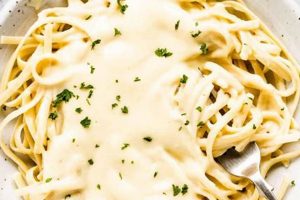This layered dish presents a plant-based interpretation of a classic Italian comfort food. It substitutes traditional meat and dairy components with plant-derived alternatives, featuring pasta sheets layered with a vegetable-rich filling and a creamy, non-dairy bchamel-style sauce. The combination offers a familiar textural experience while adhering to vegan dietary principles.
Adopting this culinary approach offers several advantages. It broadens dietary options for individuals following plant-based lifestyles or those with dairy sensitivities. Furthermore, it can contribute to a reduced environmental footprint by mitigating the impact associated with animal agriculture. Historically, variations of lasagna have existed for centuries, and this modern iteration showcases the adaptability of traditional recipes to evolving dietary preferences.
The following article will delve into specific ingredient substitutions, preparation techniques, and nutritional considerations involved in creating a satisfactory rendition of this popular meal. Attention will be given to achieving optimal flavor and texture using accessible ingredients and readily available culinary methods.
Crafting a Superior Plant-Based Lasagna
The following guidelines provide essential considerations for optimizing the preparation of this dish, focusing on flavor development, textural integrity, and ingredient selection.
Tip 1: Ingredient Quality Matters. Opt for high-quality plant-based ricotta alternatives to ensure a creamy, flavorful filling. Premium vegetables, sourced fresh when possible, contribute significantly to the overall taste profile. Consider roasting vegetables like eggplant and zucchini to intensify their natural sweetness before incorporating them into the lasagna.
Tip 2: Master the Bchamel Alternative. A well-executed non-dairy “white sauce” is critical. Cashew cream, oat milk, or a blend of both can serve as a base. Ensure the sauce achieves a smooth, velvety consistency, free from lumps. Season generously with nutmeg, white pepper, and a touch of lemon juice for brightness.
Tip 3: Layering Technique is Key. Maintain an even distribution of ingredients throughout each layer. Avoid overloading individual layers, as this can lead to uneven cooking and a soggy final product. Alternate between pasta sheets, vegetable filling, and the non-dairy white sauce.
Tip 4: Preventing Soggy Pasta. Par-cooking the lasagna noodles before assembly can help prevent excessive moisture absorption during baking. Drain the noodles thoroughly and allow them to cool slightly before layering. Some prefer oven-ready noodles to streamline this process, but consider the texture and flavor implications.
Tip 5: Enhance Flavor Depth with Umami. Incorporate umami-rich ingredients such as sun-dried tomatoes, nutritional yeast, or a small amount of miso paste to add depth and complexity to the overall flavor profile. These additions enhance the savory notes and create a more satisfying culinary experience.
Tip 6: Proper Baking is Essential. Bake the lasagna covered with foil for the majority of the cooking time to prevent the top from browning prematurely. Remove the foil during the last 15-20 minutes to allow the top layer to achieve a golden-brown hue. Ensure the internal temperature reaches a safe and desirable level throughout.
Tip 7: Allow for Resting Time. Before slicing and serving, let the finished creation rest for at least 15-20 minutes. This allows the layers to set, preventing the lasagna from falling apart and ensuring a cleaner, more presentable slice. It also allows the flavors to meld and deepen.
By adhering to these guidelines, a satisfying and flavorful rendition of this dish can be achieved, offering a delightful plant-based alternative to a classic favorite.
The conclusion will explore additional serving suggestions and potential variations to further enhance the dining experience.
1. Texture
Texture is a critical component in the perceived quality and satisfaction derived from any culinary creation, including plant-based adaptations of classic dishes. In the context of a plant-based layered dish with white sauce, textural considerations are paramount, as the absence of traditional animal-derived ingredients necessitates meticulous attention to replicating familiar and desirable mouthfeel.
- Pasta Sheet Integrity
The texture of the pasta sheets forms the foundational layer. Overcooked pasta becomes mushy and detracts from the structural integrity of the entire dish. Conversely, undercooked pasta can be unpleasantly firm. Proper cooking, often involving par-boiling or selecting oven-ready varieties, is essential to achieving a yielding yet discernible bite.
- Vegetable Filling Consistency
The vegetable filling’s texture should provide a balance between softness and substance. Finely diced or pureed vegetables may lack textural interest, while excessively large or undercooked vegetables can create an uneven mouthfeel. Roasting or sauting vegetables before assembly helps to soften them and intensify their flavors, contributing to a more cohesive texture.
- Non-Dairy Bchamel Smoothness
The white sauce’s texture is crucial for delivering a creamy, luxurious sensation. Lumps or graininess in the sauce detract from the overall experience. Achieving a smooth, velvety consistency often requires careful blending, straining, or the use of specific plant-based milk varieties with higher fat content. The sauce should coat the other ingredients without being overly thick or thin.
- Structural Layering Stability
The overall texture of the completed dish relies on the interplay between the individual layers. Excessive moisture content, whether from under-drained vegetables or an overly liquid white sauce, can lead to a soggy, unstable structure. Proper layering techniques, combined with baking and resting periods, allow the components to meld and create a cohesive, texturally pleasing whole.
Collectively, these textural elements define the eating experience, transforming a collection of plant-based ingredients into a convincing and satisfying interpretation of a classic comfort food. Success hinges on meticulously controlling each component’s texture and ensuring their harmonious integration within the final product.
2. Flavor
Flavor, the complex interplay of taste and aroma, represents a fundamental aspect of any culinary creation. Within the context of plant-based layered pasta with white sauce, flavor becomes especially critical. The absence of traditional dairy and meat components necessitates a deliberate and nuanced approach to achieve a satisfying and palatable result. Inadequate attention to flavor development can lead to a bland, uninspired dish, failing to replicate the richness and complexity of its conventional counterpart. The flavor profile is directly affected by the inherent tastes of the plant-based substitutes and the preparation methods employed.
Specifically, the vegetable filling contributes significantly to the overall taste. Consider, for instance, roasted vegetables, such as eggplant and bell peppers, which introduce smoky and sweet notes, increasing the flavor complexity. Fresh herbs, such as basil and oregano, provide aromatic depth and brightness, countering the potentially heavy nature of the sauce and pasta. Moreover, incorporating umami-rich ingredients like sun-dried tomatoes or mushroom powder enhances the savory dimension. The non-dairy white sauce must also contribute to the overall flavor. A cashew-based sauce, if not properly seasoned, can taste bland or excessively nutty. Balancing the nuttiness with ingredients such as nutmeg, garlic powder, or a touch of lemon juice is necessary to create a well-rounded flavor profile that complements the other components. Poorly prepared vegetables or a bland sauce can result in a final product that lacks both depth and appeal.
Therefore, the successful creation of plant-based layered pasta with white sauce necessitates a meticulous focus on flavor. This includes the careful selection of ingredients, thoughtful application of cooking techniques to enhance natural flavors, and strategic use of herbs and spices to create a layered, compelling taste experience. Addressing the challenges inherent in replicating traditional flavors through plant-based alternatives underscores the importance of understanding flavor dynamics in this particular culinary application.
3. Ingredients
The selection and quality of ingredients are paramount in determining the success of any plant-based rendition of a classic dish. In the context of layered pasta with a white sauce alternative, the replacement of traditional animal-derived components necessitates a careful consideration of plant-based alternatives and their impact on the final flavor, texture, and overall nutritional profile. Ingredient choices directly dictate the dish’s adherence to vegan principles while simultaneously affecting its palatability and resemblance to the original.
- Pasta Sheets
The foundation of the dish requires pasta, often wheat-based, though gluten-free options exist. The choice of pasta affects the texture and cooking time of the lasagna. Semolina pasta is a common choice for its structural integrity, while fresh pasta can offer a more delicate texture. In either case, the pasta must be cooked al dente before layering to prevent a mushy final product. Gluten-free lasagna sheets, typically made from rice or corn flour, need careful monitoring during cooking as they are often more delicate than wheat-based varieties.
- Vegetable Filling
The filling provides the primary flavor and nutritional content. Common vegetables include spinach, zucchini, mushrooms, and bell peppers. Roasting the vegetables prior to layering enhances their flavor and reduces moisture content. The specific combination of vegetables can be tailored to individual preferences and seasonal availability. Some preparations may also include plant-based ground meat alternatives to mimic the texture and savory flavor of traditional meat lasagna.
- Non-Dairy White Sauce (Bchamel)
The white sauce is a crucial element, providing creaminess and richness. Common plant-based substitutes include cashew cream, oat milk, or a blend of both. The sauce must be seasoned appropriately, typically with nutmeg, salt, pepper, and garlic powder, to achieve a savory and appealing flavor. A properly prepared sauce should be smooth and thick enough to coat the other ingredients without being watery. Alternative options, such as a tofu-based sauce, provide a different textural and flavor profile.
- Plant-Based Ricotta Alternative
While not always included, a ricotta alternative can add a layer of richness and texture to the filling. Common options include tofu-based ricotta, made by pressing and crumbling firm tofu, or cashew-based ricotta, created by blending soaked cashews with lemon juice, nutritional yeast, and herbs. Tofu ricotta tends to have a slightly firmer texture, while cashew ricotta is generally creamier. The ricotta alternative should be seasoned to complement the other ingredients and provide a satisfying contrast to the other components of the dish.
These core ingredients, when thoughtfully selected and properly prepared, contribute to a satisfying and flavorful plant-based layered pasta dish that captures the essence of the traditional recipe while adhering to vegan dietary principles. Variations in ingredient selection offer opportunities for customization and cater to individual preferences, dietary restrictions, and available resources. The balance and quality of these components are key to the final success of the preparation.
4. Preparation
The preparation phase is critical in realizing a palatable and structurally sound plant-based adaptation of layered pasta with a white sauce alternative. Successful execution necessitates attention to detail at each step, from ingredient procurement to final assembly and baking. Suboptimal preparation can result in a dish that lacks the desired texture, flavor, and structural integrity, ultimately failing to meet expectations.
- Vegetable Pre-Treatment
The manner in which vegetables are treated before layering significantly impacts the final outcome. Roasting, sauteing, or steaming vegetables serves to both develop flavor and reduce moisture content. Excess moisture can lead to a soggy final product. For example, eggplant, known for its high water content, benefits significantly from salting and pressing to extract excess moisture before cooking. Failing to properly pre-treat vegetables will compromise the dish’s texture and overall flavor.
- Sauce Consistency Management
The consistency of the white sauce alternative is paramount. A sauce that is too thin will result in a watery lasagna, while a sauce that is too thick may be difficult to spread evenly. Achieving the correct consistency often involves careful monitoring of the cooking process and precise measurement of ingredients. Starch-based thickeners, such as cornstarch or tapioca starch, may be necessary to achieve the desired viscosity. Inadequate sauce consistency management affects both the texture and flavor distribution throughout the dish.
- Layering Technique
The layering process itself influences the structural stability of the final product. Even distribution of ingredients across each layer is crucial to prevent collapse or uneven cooking. Overloading individual layers can lead to sogginess and difficulty in slicing. Alternating layers of pasta, vegetables, sauce, and plant-based ricotta alternative ensures a balanced distribution of flavors and textures. A haphazard layering technique will detract from the visual appeal and structural integrity of the dish.
- Baking Protocol Adherence
Proper baking, including time, temperature, and covering protocols, is essential for achieving a fully cooked and visually appealing dish. Initially covering the dish with foil prevents excessive browning of the top layer. Removing the foil during the final minutes of baking allows for a golden-brown crust to form. Insufficient baking can result in undercooked pasta or a watery filling. Overbaking, on the other hand, can lead to a dry and hardened dish. Adherence to a precise baking protocol ensures a properly cooked and visually appealing final product.
These facets of preparation, when executed meticulously, contribute to a successful plant-based layered pasta dish that emulates the desired characteristics of its traditional counterpart. Attention to detail throughout the preparation phase is crucial for overcoming the challenges inherent in replacing animal-derived ingredients and achieving a satisfying culinary outcome. The cumulative effect of these preparation steps determines the final quality and palatability of the dish.
5. Presentation
Presentation significantly impacts the perception and enjoyment of layered pasta with a plant-based white sauce. The visual appeal of the dish, often the initial sensory experience, sets expectations for taste and texture. A carefully presented lasagna communicates care and culinary skill, potentially enhancing the diner’s anticipation. Conversely, a poorly presented lasagna may detract from the eating experience, even if the taste is satisfactory. The cause-and-effect relationship is direct: aesthetically pleasing presentation enhances perceived quality, while unappealing presentation diminishes it. For example, a lasagna with clearly defined layers, a golden-brown crust, and cleanly cut edges conveys professionalism and attention to detail. Conversely, a collapsed, soggy, or irregularly sliced lasagna suggests a lack of care or technical skill.
Effective presentation strategies for plant-based lasagna include selecting an appropriate serving dish that complements the colors of the ingredients. Garnishing with fresh herbs, such as basil or parsley, adds visual interest and a touch of freshness. The use of contrasting colors within the filling, achieved through strategic vegetable selection, can enhance visual appeal. Precise slicing, achieved with a sharp knife and a cooling period after baking, is crucial for maintaining the integrity of the layers. Consider the impact of sauce distribution; an evenly applied white sauce creates a smoother, more appealing surface. From a practical standpoint, these techniques can be implemented by home cooks and professional chefs alike, requiring only minimal additional effort but yielding significant returns in terms of perceived quality and diner satisfaction.
In conclusion, presentation is not merely an aesthetic concern but an integral component of the overall dining experience. By paying attention to layering, color, slicing, and garnishing, the visual appeal of layered pasta with plant-based white sauce can be significantly enhanced. While taste and texture remain paramount, a visually appealing presentation sets a positive expectation and contributes to a more satisfying and complete culinary experience. Ultimately, mastering the art of presentation transforms a simple meal into a visually compelling and memorable dish.
6. Nutrition
The nutritional profile of layered pasta with a plant-based white sauce is directly influenced by ingredient selection and preparation methods. Compared to traditional lasagna, this variation may offer distinct advantages and disadvantages regarding macronutrient composition, micronutrient density, and overall dietary impact. For example, substituting animal-derived products with plant-based alternatives can alter the fat content, fiber content, and the presence of specific vitamins and minerals. The cause-and-effect relationship is evident: the type and quantity of vegetables used directly impact vitamin and mineral content. Similarly, the choice of plant-based milk affects the calcium and vitamin D levels. The importance of nutrition as a component of this dish lies in its potential to provide a balanced and healthful meal, or, conversely, to contribute to dietary imbalances if not carefully constructed.
The practical significance of understanding the nutritional aspects becomes apparent when considering specific ingredient substitutions. Replacing traditional ricotta with a tofu-based alternative, for example, reduces saturated fat and cholesterol while increasing plant-based protein. Incorporating a variety of colorful vegetables enhances the intake of vitamins A and C, as well as antioxidants. The type of plant-based milk used in the white sauce also affects the calcium content; fortified soy or almond milk can provide comparable levels to cow’s milk. Conversely, relying solely on processed vegan cheese alternatives might increase sodium and saturated fat levels. The caloric density and macronutrient ratios vary greatly depending on the specific recipe, and careful attention must be paid to portion sizes to maintain a balanced diet. Real-world examples include individuals with lactose intolerance or those following a vegan diet who can benefit from this alternative, provided they prioritize nutrient-rich ingredients. Conversely, those focusing solely on weight loss might need to carefully manage portion sizes and ingredient choices due to the potential for high carbohydrate and fat content.
In summary, the nutritional value of layered pasta with a plant-based white sauce is a dynamic outcome of ingredient choices and preparation techniques. By prioritizing whole, unprocessed plant foods, such as diverse vegetables, legumes, and fortified plant-based milks, this dish can become a valuable component of a balanced diet. Challenges lie in achieving a favorable macronutrient ratio, minimizing sodium and saturated fat, and ensuring adequate intake of essential vitamins and minerals. Understanding these nutritional dynamics enables individuals to make informed choices and optimize the health benefits of this plant-based adaptation. The broader theme centers on the power of culinary adaptation to create nutritious and appealing meals that align with individual dietary needs and ethical considerations.
Frequently Asked Questions
The following addresses common inquiries and misconceptions surrounding the preparation and consumption of this dish, offering clear and concise information for informed decision-making.
Question 1: Is plant-based layered pasta with white sauce nutritionally complete?
Nutritional completeness is contingent upon the ingredients utilized. A well-constructed recipe incorporating a variety of vegetables, legumes, and fortified plant-based milks can provide a balanced source of macronutrients and micronutrients. However, reliance on processed ingredients or limited vegetable variety may result in nutritional deficiencies. Careful planning and ingredient selection are essential to achieving a nutritionally complete meal.
Question 2: Can this dish be adapted for gluten-free diets?
Adaptation for gluten-free diets is feasible through the substitution of conventional pasta sheets with gluten-free alternatives made from rice, corn, or other gluten-free flours. However, the texture of gluten-free pasta may differ from wheat-based pasta, and cooking times may require adjustment. Selecting a high-quality gluten-free pasta specifically designed for lasagna is recommended.
Question 3: How does plant-based white sauce compare to traditional bchamel?
Plant-based white sauces, typically made from cashews, oats, or other plant-based milks, differ significantly from traditional bchamel in terms of fat content and cholesterol levels. Plant-based versions generally contain less saturated fat and are cholesterol-free. The flavor and texture may also differ, requiring careful seasoning to achieve a similar level of richness and creaminess. Nutritional yeast can provide a savory, cheesy flavor often associated with traditional bchamel.
Question 4: What is the best way to prevent a soggy plant-based layered pasta dish?
Preventing sogginess involves meticulous attention to moisture management. Roasting or sauteing vegetables prior to layering reduces their water content. Ensuring that the white sauce is not overly thin and using properly cooked pasta sheets are also crucial. Allowing the finished dish to rest for at least 15-20 minutes after baking allows the layers to set and prevents the lasagna from falling apart.
Question 5: Can plant-based layered pasta with white sauce be prepared in advance?
Pre-preparation is possible, and often advantageous, as it allows the flavors to meld and deepen. The assembled dish can be refrigerated for up to 24 hours before baking. However, extended refrigeration may result in excessive moisture absorption by the pasta sheets. Adding a layer of sauce between the pasta and the vegetables can help to mitigate this effect. The baking time may need to be adjusted slightly when baking from a chilled state.
Question 6: What are some common mistakes to avoid when making plant-based layered pasta with white sauce?
Common mistakes include using under-seasoned ingredients, failing to properly pre-cook or drain vegetables, using an overly thin white sauce, and overbaking the dish. A lack of attention to layering technique and a failure to allow sufficient resting time after baking can also negatively impact the final result. Avoiding these pitfalls through careful planning and execution is essential to achieving a successful outcome.
Understanding these frequently asked questions contributes to a more informed approach to preparing and enjoying this culinary adaptation. Attention to detail and informed ingredient selection are key to overcoming common challenges and achieving a satisfying result.
The subsequent section will explore potential variations and advanced techniques for further enhancing the dining experience.
Concluding Remarks
This exploration of the culinary adaptation, vegan lasagna with white sauce, has illuminated essential considerations for crafting a palatable and structurally sound rendition. Key aspects include ingredient selection, preparation techniques, and an understanding of flavor dynamics. Successfully executing this dish requires attention to detail, particularly in replicating the textures and flavors of its traditional counterpart through plant-based substitutions. The analysis of common pitfalls, such as moisture management and sauce consistency, provides practical insights for overcoming potential challenges.
The ability to recreate classic dishes using plant-based ingredients underscores the ongoing evolution of culinary practices. As dietary preferences shift and ethical considerations gain prominence, the adaptation of familiar recipes will continue to be a relevant and important area of culinary innovation. Vegan lasagna with white sauce serves as an example of how traditional dishes can be reimagined to meet contemporary dietary needs while retaining a connection to culinary heritage.







